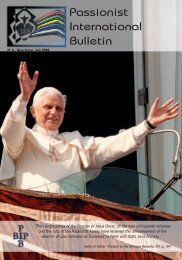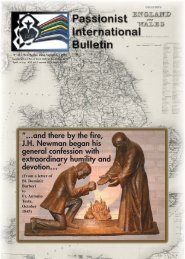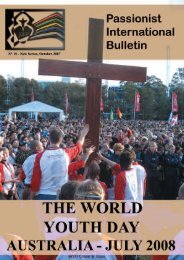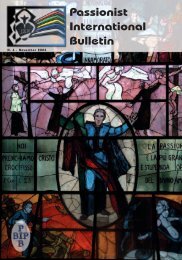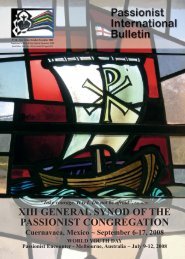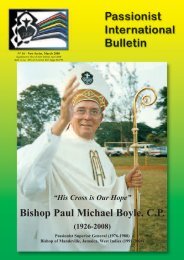seminar on the memoria passionisTHE WORK: “LA PASSION DU CHRIST ET LE PHILOSOPHIES”AND SUCCESSIVE DEVELOPMENTS IN THE THEOLOGY OF THE CROSS“In its essence, would not being as being be consubstantial with the cross?”Fr. Adolfo Lippi, C.P.16Published by the “Eco” Press at San Gabrieledell’Addolorata, this work, the fruit of the early years of theteaching of Breton in Roman universities, it is one of themost important of his early works. It anticipates what wouldbe the theme of the theology of the cross in Catholic theology,and which would be developed in the years followingVatican Council II.Above all, the work contains innovative aspects.Situating itself between philosophy and Christian revelation,it breaks down a certain artificial boundary between therespective fields, which were widely discussed during thosetimes: it is sufficient to consider Blondel and De Lubac. It isbelieved that there could be a relationship between philosophyand theology with regard to the concepts used in thestudy of the essence of God or of the Trinity and theIncarnation, but not about that which, since the time of theAreopagus, was considered scandalous thought, the cross.The Passion of Christ—says Breton—is not a philosophyand it cannot be rationalized, but it gives philosophy foodfor thought. Analyzing the profound reflections of Hegel, ofNietzsche, of Blondel of Simone Weil, of Alain and re-situatingthem in the Biblical and Greek (Plato, the tragedies)sources of western thought, Breton shows the extraordinaryimportance of meditation on the suffering of humanity andon the prospective of the cross. The study that Breton doesof Hegel goes beyond even that which the lay schools haddeveloped on this philosopher, revealing that it deals with atrue philosophy of the cross, which however doesn’t capturethe essence ofChristian revelationand thereforecannot becalled theologiacrucis.Under thetitle GradusPassionis, connectedwith awidespreaddevotion amongthe <strong>Passionist</strong>s,Breton thenascends thestairway of the various philosophical interpretations of thecross. The central point is the concept that the cross touchesthe same definitiveness of Divinity. Here too, Breton anticipatesa topic that was highlighted by several Fathers of theSome of the most important philosophical works of BretonChurch, then forgotten, and which would be successivelydisseminated in theology with presentations, at times superficially,of the suffering of God as God, connected with thetopic of the mutability or immutability of God. He expressesthe very profound difficulty implicit in Christian revelationwith the question that I used as a subtitle for this conference:In its essence, would not being as being be consubstantialwith the cross? The theological reasonableness ofthis question is associated with the presentation that Bretonoffers on agape as constitutive of God according to the NewTestament and as the objective coincidence between agapeand the cross. It is important to observe that Breton does notlimit himself to proposing an identity between the eternalWord of God and the cross – a topic significantly present incurrent theology – but between being as such, being that isthe foundation of philosophy, the tò on è on, that fromAristotle up to Heidegger is the main theme of western philosophy.The final section of the work of Breton presents aphilosopher that looks upon the cross, an agnostic thatmediates on the cross. Above all, we return to severalthemes of Alain and of Simone Weil: the cross attracts, it issomething that kìnei os eròmenon, movet in quantum amatum,with regard to the power of weakness. What an error tohave turned it into a symbol of power and domination!Breton proceeds then on his own with the meditation on thecross from the point of view of philosophies and concludessaying that he believes that whoever believes feels invited toreflect and to take from the cross reasons for a new vision ofthe world; but if one is not moved by the Spirit, philosophyis not sufficient to reveal the cross.The present conference presents two important elementsof the work of Breton: that contained in the Theology of thethree days, of Han Urs von Balthasar and that of Eslin, in thecollected works originating in a meeting on Breton, at whichPaul Ricoeur also participated.The conference concludes by again focusing on a studyon Breton done by his friend Henri Duméry. This revealsthat the thought of Breton has drawn on various sources,from those of Thomism, phenomenology, idealism, andeven Marxism. Breton dialogued with Christians, Jews,Buddhists, and Marxists: at the root of everything there wasalways what Duméry calls le passioniste, the <strong>Passionist</strong>quality of Breton. He is an external witness, very importantfor us <strong>Passionist</strong>s. In the mysticism of the Passion – saysDuméry – Breton discovers a richness that is able to nourishall the philosophies of the world.
seminar on the memoria passionisTHE MEMORY OF THE MESSIANIC PASSION FROM THE PERSPECTIVEOF THE SPIRITUALITY AND RESEARCH OF STANISLAS BRETONFr. Max Anselmi, C.P.The sources for understanding the thought of Bretonon the PassionWhoever wishes to understand the passiologicalthought of Breton in its central elements, cannot limithimself to only one of his works, because it would not besufficient; rather, one needs to consider at least the principalpublications that substantially correspond to thevarious decisive moments of his life and the history of histhought and that can also be considered representative ofthe others.Up until the mid 1990’s, scholars refer to two works:“La passione di Cristo e le filosofie “ of 1954 (cf. trad. it.Ed. Stauros, Pescara 1982) and “ Il verbo e la croce “ of1981 (cf. trad.it. Ed. Stauros, Pescara 1983). Howeverwhat is not cited is the volume that deals with the doctrinalthought of St. Paul of the Cross: “La mistica dellapassione. Studio sulla dottrina spirituale di S. Paolo dellaCroce “ of 1962 (trad. it. Ed. Stauros, Pescara 1986) andwhich, together with two others, form a trilogy by thesame author (Cf. Stanislas Breton, Vers une théologie dela Croix, San Gabriele (TE) 1981, p. 7. Cf. also: ClaudeRoyon, Dieu, l’homme et la croix. Stanislas Breton etErhard Jüngel, Paris 1998, p. 15). The scant acquaintancewith the volume may be attributed to its title, making onethink that “The mysticism of the Passion” may be aresearch of pure and simple spirituality, while in reality, itis truly a unique work that expresses the philosophicalthought of Breton regarding the cross. There is no doubtabout the fact that “La mistica della Passione “ may beand remains a kind of general proof of the application ofphilosophy or of a type of passiological philosophy.Whoever wishes to understand the philosophical thoughtof Breton concerning the cross cannot bypass “The mysticismof the Passion”, because, amidst its passiologicaltexts, it is, even today, one of the principal ones andremains even now, one of the most essential.Modernity and “passion-ism”Given the insistence and theimportance accorded by Breton tothe passiological element for makingpossible thought that is demandingand critical and contemporaneouslycurrent in comparison withthe world and modern times, hisefforts become classified as “passionism”(Cf. Claude Royon, Dieu,l’homme et la croix. StanislasBreton et Erhard Jüngel, p. 32.) Forthis reason, in order to characterizehis thought on the passion, scholarshave preferred to focus their attentionin this endeavor by referring back to Breton and havemoved almost exclusively to recent publications and theconstant and prevailing references that are concentratedin the following works: “Unicité et Monothéisme”(1981), “De Rome à Paris. Itinéraire philosophique”(1992), “Philosophie et mystique” (1996) Cf. StanislasBreton, Philosophie et mystique. Existence et surexistence,Edidions Jérôme Millon, Grenoble 1996, pp. 187)and, finally, “L’avenir du christianisme” (1999), thatseem to constitute the organic, summarized and completere-elaboration of the other three works just mentioned.The history of his philosophical and cultural endeavorsDuring 1971, Breton produced a substantial number ofarticles both published and unpublished, entitled: “Foi etraison logique,” where he takes various viewpoints onthe rational demands of faith that is aware of its ownspecificity. In this collection, perhaps necessitated byexternal factors, saying that he had to do it “under pain oflife or death”, he presents us with a “small history” of histhought (cf. Postface, in: Foi et raison logique, p. 267-280). The summary is important because we learn, in asingle image, the various connections among his diverseresearch topics, beginning with his thesis: “L’esse in etl’esse ad dans la métaphysique de la relation”, up to thedevelopment of Hussite phenomenology, later abandoned,because it did not further the argument; howeverthe others that are mentioned, the project of the philosophic“quasi-trilogy”, whose initial study should takeinto consideration thought in keeping with his principles;secondly, thought with regard to the world and, finally,thirdly, the thought that takes into account power and alsoweakness. The first of these three fundamental operationsof thought was confronted by Breton in “Du Principe” of1971, the second in the work, “”Etre, monde, imaginar-17



